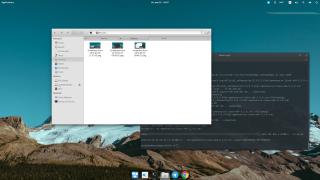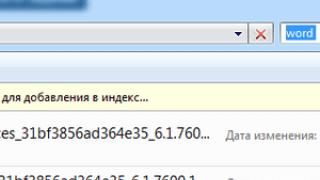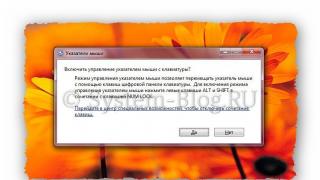Outlook Express is a lightweight, older version of Microsoft's famous email program. The company no longer supports it, but Express is still widely used by users who have not migrated to newer versions of Windows. Compared to the modern version of Outlook, it has a number of features that are worth knowing in order to set up a mailer before starting work.
How to configure Outlook Express to work with different sites
In order for messages from existing mailboxes to be redirected to Outlook Express, the program needs preliminary configuration. The configuration process is very similar for different mail sites, differing only in the data that must be entered and the protocols that can be used.
There are currently two protocols: IMAP and POP. IMAP is more functional, but POP is faster and "lighter". Which one is better is up to you, but the sites themselves prefer to provide data only for POP.
 In the settings of Outlook Express accounts, you can add a new mail address
In the settings of Outlook Express accounts, you can add a new mail address The first thing to do when setting up is to enter your username
The first thing to do when setting up is to enter your username You must enter the email address from which you will receive messages
You must enter the email address from which you will receive messages Server input for incoming and outgoing messages using Mail as an example
Server input for incoming and outgoing messages using Mail as an example You need to enter your username and password to log in to the system
You need to enter your username and password to log in to the system To configure the properties of an account, you need to enter the appropriate panel, find the desired address and click "Properties"
To configure the properties of an account, you need to enter the appropriate panel, find the desired address and click "Properties" In the window that opens, you can change the account settings
In the window that opens, you can change the account settingsTable: server data for different mailboxes
| Yandex | Ukr.net | ||
| Inbox |
|
pop.yandex.ru | pop3.ukr.net |
| Outbox | smtp.mail.ru | smtp.yandex.ru | smtp.ukr.net |
Where messages and Outlook Express profile are stored
Knowing where all incoming and outgoing mail is located can be extremely important, for example, when reinstalling the system. fortunately, there is no mystery about this: by default, the program uses the following path. Accounts are also located in the same folder. But the passwords to them are encrypted deep in the registry, and you just can't get to them - only with the help of special programs.
C: \ Documents and Settings \<имя пользователя>\ Local Settings \ Application Data \ Identities \ (identification number) \ Microsoft \ Outlook Express
Sergei
mail.ru
Here "Username" is the name of your computer's account, and the identification number is some long number that may differ depending on the configuration.
It is worth noting that you will not be able to enter this folder just like that: you may need administrator rights and the disabled option "Hide system files and folders". This can be done in the settings menu along the following path: "Start - Control Panel - Files and Folders / Explorer Options / Folder Options / Folder Options (depending on the version of Windows, this item is called differently)".
By the way, the storage location of letters can be changed: this is done in the Outlook Express settings along the path "Service - Options - Maintenance - Message Bank".
 In Outlook Express, you can view and configure the location where data will be stored
In Outlook Express, you can view and configure the location where data will be stored Disable compression
By default, Outlook Express asks the user every time the program is closed if he wants to compress messages to free up some disk space. Even if the user answers “OK”, after a while the client will ask him about it again. And if you click on "Cancel", the program will start offering compression every time. Users generally find this feature annoying and want to get rid of it.
 This message appears very often in Outlook Express and interferes with your work
This message appears very often in Outlook Express and interferes with your work In older versions, the problem is solved simply: just go to the "Service - Options - Maintenance" path and uncheck the "Compress messages" item in the window that appears.
 D older versions of Outlook Express to disable compression, just uncheck the "Compress ..." item in the settings
D older versions of Outlook Express to disable compression, just uncheck the "Compress ..." item in the settings But with new ones you have to work hard. It is impossible to disable compression there, and a notification window starts to appear every time the program is launched, if the number of times the user has turned on the program exceeds 100. Obviously, Microsoft believes that after a hundred applications of the program, the message store grows to unimaginable sizes.
It is impossible to get rid of the annoying offer forever. But you can reset the inclusions counter.
Outlook Express is easy and convenient to use if you know how to set it up. It can be a good assistant in sorting and sending letters from different mailboxes. And if it starts to bother you with compression, you can always turn it off!
After you have registered your mail account for efficient and convenient work with your correspondence, you need to use special mail programs that make our life much easier.
In this article, I will walk you through the process of configuring the Microsoft Outlook Express mail program and describe in detail all the steps required for this.
When we start Outlook Express for the first time, we see the following window:
The first thing we need is to enter our name in the name input field, here you can enter any name or nickname you like. It will be displayed in the From field of this letter.
After filling in the name field, the "next" button will light up, go to it and see the following window:

here, in the field for entering the e-mail address, we enter the e-mail you registered, here it is important to enter it accurately. After entering the address, click "next" and get to the next window:

In the field for selecting the server of incoming messages (1), as a rule, the POP3 protocol is most often used. So, first, select it, in case of an error, try to select another protocol, IMAP for example. POP3 is used to store the mailbox on the user's computer, and IMAP is used on the server.
In the field (3) server of outgoing messages, you must also enter the address of this server.
In my case, the data for the incoming and outgoing server is the same, but this is not always the case, as a rule, they are different.
After entering all these data, go to "next". Please note that all these three fields are required, moreover, the performance of your mailbox will depend on how correctly you fill them in. Therefore, here you need to enter all this data correctly.
After the transition, we get to such a window:

In the field "account" we enter the username you have chosen, to enter the mail, as a rule, you basically only need to enter a username here, but in some cases it is also necessary to enter a domain, for example: [email protected] site, here it is already individually. But first, I recommend trying to just enter the login, without any domains.
In the “password” field, enter the password you invented, you can also select the “remember password” checkbox so as not to enter it all the time. We pass "further". The following window appears in front of us:

where we are congratulated on the successful setup of mail. We press "done". And we check the efficiency of the mailbox. To check the mailbox, you must press the key combination Ctrl + M or press the key:

or choose Tools> Deliver Mail> Deliver Mail.
Any difficulties, questions? Write in the comments. How can I help.
Today, dozens of companies offer e-mail services, and these are only the largest in the Russian Internet. All of them are equipped with web interfaces that allow you to work through a browser, but it's too early to discount universal email clients, they are still in demand.
Setting up Outlook
Microsoft Outlook is a popular, easy-to-use application that makes it easy to organize personal and group work on the Internet. The program is used for exchanging mail, scheduling business meetings and assignments, maintaining a list of necessary contacts. It is one of the most popular, which is well deserved. It was developed by Microsoft Corporation, the author of the well-known set of office applications and many other programs and digital technologies. But for correct operation, the program must be configured depending on the used mail service. Setting up Outlook is quite simple, even an inexperienced person can handle it. The article provides examples of configuration for Mail.Ru and Yandex. But first, a few words about other features of this program.
Outlook features
Business is not limited to the usual work with mail. In fact, it is a multifunctional organizer.
- Contacts. A convenient folder where all the necessary email addresses and phone numbers are stored. Often users enter birth dates here for contact persons.
- The calendar. Used for planning important events and meetings.
- Diary. This is where information about Outlook is automatically saved.
- Tasks. With this function, you can save important tasks, tasks and assignments.
- Notes. The program resembles a loose-leaf notebook. Suitable for recording reminders and various information. As you can see, the program has many interesting and useful options besides the usual receiving and sending mail.
General setup
If you use specialized mail, for example, corporate work or from a provider, Outlook setup consists of the following items:
- Open the application, find "Accounts" in the "Service" menu and click on them.
- Click the "Mail" tab, then "Add". A window will appear on the right where you need to select "Mail".
- Enter the last name and first name of the mailbox owner.
- In the "E-mail" add the required address.
- Specify POP3 in the "E-mail servers", and write the required mail domain in the lower fields.
- In the "Login to the Internet mail" in the "Account" write the username and specify the password on the appropriate line.
- Save all actions with the "Next" and "Finish" buttons.
Ordinal setting
The sequential configuration of Outlook is done as follows:
- Switch on the program. In the window that opens, select "Email Accounts".
- Then click on "Add new", then "Next".
- Select POP3 from the list of servers.
- In the line "Enter your name" enter your personal data, in the "E-mail address" enter your e-mail address, opposite the "User" and "Password" indicate the full name of the box, the password for access to it. On the empty fields of the server of incoming and outgoing mail, type mail / your domain name. Confirm the changes with the "Next" button.
- Then click on "Other settings", select "Outgoing mail server" and check "SMTP server requires identity verification".
- Save by clicking "Ok".

Setting for Yandex
Yandex began to provide e-mail services in 2000. Since then and to this day, this postal service has been one of the most popular in the Russian Internet. Yandex easily provides its customers with the ability to exchange emails, regardless of the provider and the connection to the network of their opponents. Most often, Outlook for Yandex is configured using the POP3 protocol. This is done quite simply. So, setting up Outlook mail is done as follows:
- Start Outlook.
- Go to "Service", select "Account Settings".
- In the window that appears, click on "Create".
- When "Create an account" opens, mark "Manually configure server settings or additional server types", then "Next".
- In the new window, select "E-mail", then in the "Internet e-mail settings" type the following: your name, which the recipient will see when he receives a letter from you, his mail address. In the required fields, specify pop.yandex.ru as incoming, smtp.yandex.ru as outgoing. In the "User" indicate your username on this provider. For example, if the address [email protected], then only the first part needs to be entered. Enter your own in the password line.
- In the "Internet e-mail settings" on the "Outgoing mail server" mark "SMTP server" and the bottom line "Similar to the server for incoming mail".
- Then in the "Advanced" select an encrypted connection and the function of saving a copy of the correspondence on the server.
Save with the "OK" button. Setting up Outlook for Yandex is complete.

Setting up for Mail.Ru
Mail.Ru, another leading company in the Russian segment of the Internet, like many others, started out with just a simple email and search engine. Setting up Outlook for Mail.ru is not difficult. Follow the instructions below carefully. It doesn't take long to set up Outlook mail.
- The entry type is IMAP.
- In the incoming mail "Hostname" - imap.mail.ru, "User" - the full address of the personal mailbox. Enter the password in the required field.
- In outgoing mail everything is the same, smtp.mail.ru in the line "Hostname".
- In the "Additional settings" activate "Use SSL", in the "Server port" dial 993 - for incoming letters. For outgoing, change only the "Server port". You need to write 465.

Outlook Express
It is believed that Outlook Express is a kind of light version of the classic Outlook. This is partially true. They have one developer, and Express was shipped with the OS from Microsoft until 2003. With the release of Windows 7, distribution stopped.
Their differences are that the classic was included in the Microsoft Office suite, while Express was preinstalled in the operating system. The latter also lacks various additional functions. Setting up Outlook Express consists of the following steps:

- Launch the application, open "Service", "Accounts".
- Select the "Mail" tab.
- In "Add" we click on "Mail".
- Specify the name or alias that the recipient will see in the "From" line.
- Enter your e-mail and "Next".
- Select POP3 from the list of servers for incoming mail.
- Specify parameters for outgoing mail.
- Enter your mailing address in the "Account".
- Enter your password.
- Click "Next" to complete the settings.
Launching the mail program
Run: Start - All Programs - Outlook Express. The main window appears, displaying Local folders (i.e. outgoing, sent and deleted messages). If a message appears that Outlook Express is not the default program for working with email, and the question is: "Make it one?" - answer Yes. If nothing like this happens, we continue with the configuration.

Select the Always open inbox at startup check box. The mail program directs all incoming messages to the Inbox, so it makes sense to skip this start page. If you don't see a list of folders and contacts on the left, choose Current View from the View menu. Select Contacts & Folders to check the boxes, then the OK button.
Creating a new account.
Open the menu item "Tools - Accounts ...".

Go to the "Mail" tab (usually we are on it by default). Already created accounts are displayed here. Click the Add - Mail button.

Computer service Positive provides services for the transfer and setting up the mail program Outlook Express on another computer or after reinstalling the Windows 7 and Vista operating system
In the "Displayed name" field, enter any name you like (it can be your name or the name of your company). It will be displayed to the recipient of the letter in the "From" field.


Account setup
Now enter your email servers:
- In the drop-down list "Server of incoming messages" select "POP3";
- In the field "Server of incoming messages (POP3, IMAP or HTTP)" insert "POP3", which is indicated in the letter with access parameters;
- In the field "Server of outgoing messages (SMTP)" correspondingly "SMTP" is the server of your Internet provider (ie the company that provides you with the Internet service).

We check if all the data has been entered correctly and click Next.
Enter your account name and password:
- In the field "Account" enter Login, which is indicated in the memo;
- "Password - Password" respectively. The password is entered case-sensitive (capital and small letters).

Count the number of circles in the Password field and compare it with the number of characters in the password. If the numbers are the same, check the box "Remember password" and Next. Click Finish
Checking mail.
For mailer settings, and to be sure that the mail program is working properly, send yourself a message. To do this, on the toolbar, the Create button, after which a window will appear where it says "To", enter your email address and click the Send button.

In the main window of the program, click "Deliver mail". Go to the folder of received mails, where there should be a new message (not necessarily one, there may be several). If the message is accepted, the mail program is set up and working!



